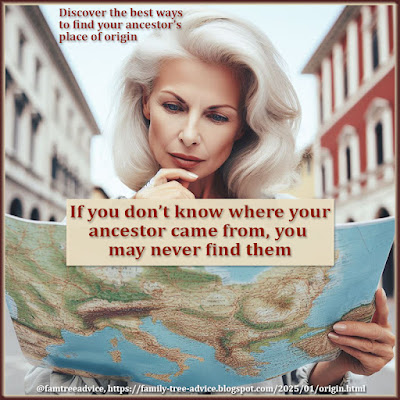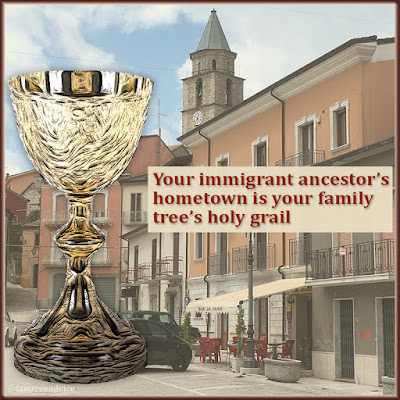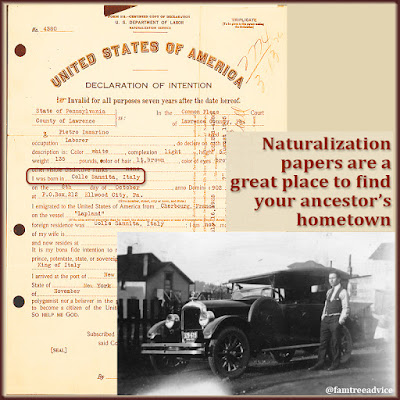My first article in this blog—eight years ago—explains the first step to take in your genealogy journey. You must find out where your ancestor came from. If you don't know your ancestor's hometown, you can't be sure any of your search results are the right person.
Most people know where their parents were born, and their grandparents, too. When I was a kid, my grandparents still lived in the building where my mother was born. My father would mention his hometown in Ohio. I knew my grandmothers were born in New York. And I heard the names of my grandfathers' hometowns in Italy many times.
It's your great grandparents who may be your first genealogy obstacle. If you don't know where they came, where will you search? You need to find clues to point you in the right direction.
 |
| You can't tell your ancestor from a stranger unless you know where they came from. |
My very first article for this blog, "Where Did Grandpa Come From?", lists five resources for finding a town of origin:
- ship manifests
- naturalization papers
- passport applications
- draft registration cards, and
- a website for tracing Italian last names. (I use a better one now.)
"4 Key Places to Discover Your Ancestor's Hometown" explores four of those resources. Using them, I broke through brick walls.
- A ship manifest and a phonetic clue led me to my great grandmother Maria Rosa Caruso's hometown in Italy.
- A World War II draft registration card pinpointed a town in Italy no one remembered.
- My grandfather's declaration of intention named his hometown—but I knew that already. What I didn't know was that his birthday was different than the one we celebrated!
- A passport application proved my grandaunt's husband had roots in the same town as her. I knew they both had the last name Sarracino for a reason!
"6 Places to Discover Your Ancestor's Town of Birth" goes a bit further. It shows how birth, baptism, marriage, and military records held important clues.
"6 Ways to Find Your Ancestor's Hometown" adds a few more tips:
- Say your relative died in an English-speaking country. It's likely his death certificate Anglicizes his parents' non-English names. My 2nd great grandmother's last name was Girardi. Every U.S. document that mentioned her had a different version of her name. With a bit of imagination, I finally figured it out.
- A marriage certificate in a person's new country may include their foreign hometown. Or it may have the name of a country you weren't expecting.
- Try a broad search for a last name only. See where everyone else with that name came from. This is how I solved my great grandmother's hometown. And she has a common last name.
- If you can't find a document for your person that has their hometown, search for their siblings. One of them may have extra documents for you to view. And one of those documents may have exactly what you need.
Finally, there's DNA. "How DNA Can Help Find Your Ancestral Hometown" explores how a DNA test can show your ancestors' origins. I'm sure my AncestryDNA communities are so accurate because my tree is so extensive. If you don't have an enormous family tree with lots of references to those towns of origin, there's still hope.
Take a look at the origins of lots of your closest matches. Which areas do you have in common? My DNA matches and I share Southern Italy. That's not too helpful unless you didn't know where your ancestors came from.
Next, take a look at any matches with a decent family tree. Also try searching for your ancestors in other people's family trees. So many people have written to me because they found their ancestors in my family tree. They got very lucky because I had the documents and the names and dates they couldn't find on their own. Be sure to use any new information to do your own research. Confirm everything!
Finding the right place of origin for your ancestors makes all the difference. Don't go down the wrong research path. You must find out where to look.


















